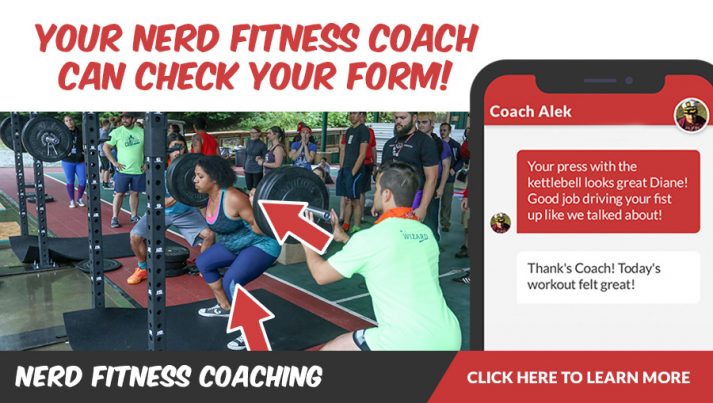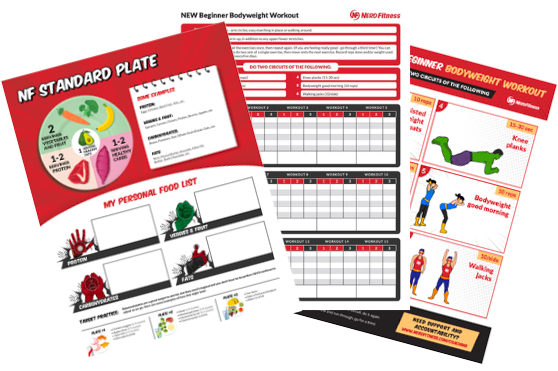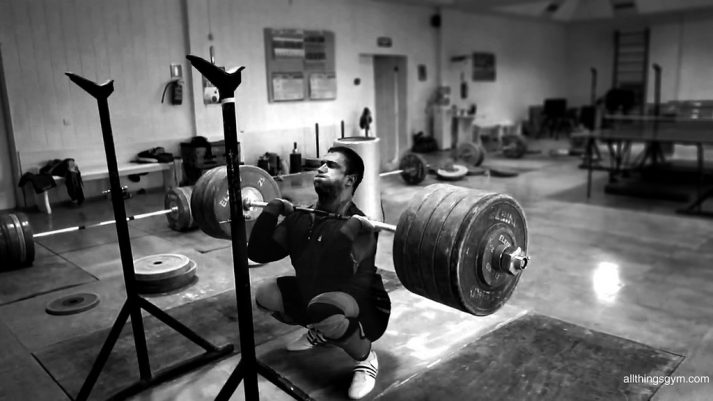
The front squat is a fantastic alternative to the traditional barbell squat.
In this guide to front squats – part of our Strength 101 series – we’re going to be covering everything you need to know about how to perform the front squat.
Teaching people how to do squats is one of my favorite things about our 1-on-1 online coaching program!
We build workout routines that help people get strong as hell, check their form via video, and even help them get their nutrition dialed in too.
If you’re ready to jump into this guide on front squats, simply click on the sections below to get to the good stuff:
- What’s are the differences between a front squat and back squat?
- How to work up to a front squat.
- Proper front squat setup (don’t skip!)
- How to front squat with proper form.
- How to bail safely on a front squat.
- 5 mistakes to avoid with your front squat.
- How to put front squats into your workouts:
Oh, and if you like this guide, we have an entire Strength 101 Guide that you can download free when you join the Rebellion (our free community).
I’ll send you the ebook when you sign up in the box below!
- Everything you need to know about getting strong.
- Workout routines for bodyweight AND weight training.
- How to find the right gym and train properly in one.
What’s ArE Differences Between a Front Squat and a Back Squat?

“Dearest Steve, HOW does a barbell front squat differ from the back squat?”
Great question, gumshoe (can I call you “gumshoe?” Cool).
This section is going to rely heavily on the bible of barbell training, Starting Strength, which I HIGHLY recommend you pick up if you’re serious about your training.
The differences between a barbell back squat and front squat is all due to the location of the bar with regards to the rest of your body.
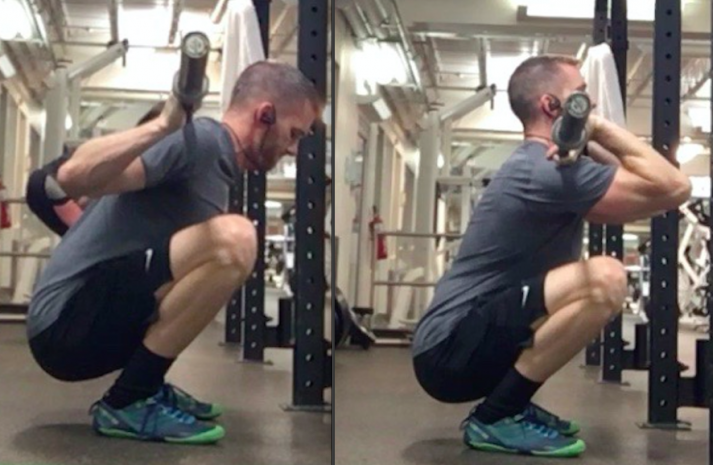
Because you keep the weight over the middle of your feet in both movements, your body needs to adjust fairly dramatically to do a front squat when compared to a back squat (below photo from Starting Strength):
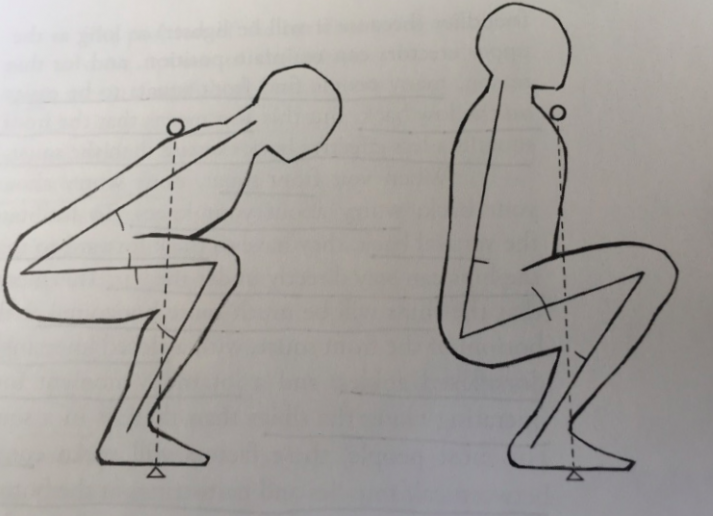
In a back squat, at the bottom of the squat your back is in a 45 degree angle[1].
However, in a front squat, due to the fact that the weight is in front of you (duh), resting on your shoulders, your torso and back need to be almost completely vertical throughout the movement to keep the weight stable!
In addition, because your back is much more upright, this requires your hips to stay under the bar, your knees to extend out further, and also your ankles to be more activated (photo below from Starting Strength)!
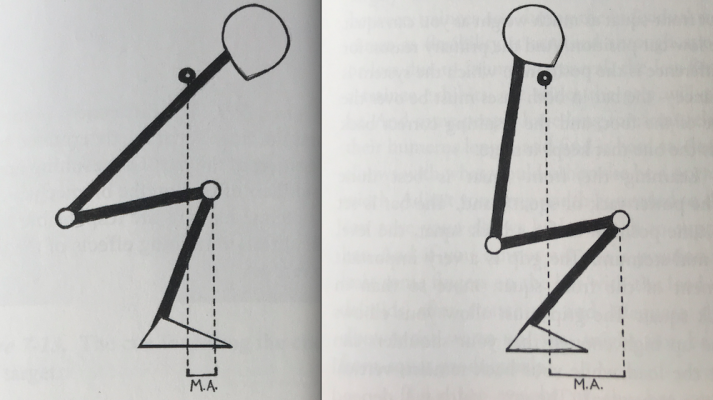
Other differences between a front squat and back squat:
- You’ll lift LESS weight than a traditional back squat.
- You might find front squats to be easier on your lower back than back squats, because you’ll be lifting less weight and your lower back is less engaged.
- Your quads are more engaged, your glutes are more engaged, and your hamstrings are LESS engaged due to your hips staying under the bar and your knees driving forward when you drop into a front squat.
Quads are the dominant muscle that have to do most of the heavy lifting in a front squat. Which means doing both front squats and back squats in your workouts is a great way to build very well developed legs and posterior.
BOOYAH.
How to Work Up to a Front Squat

The front squat is an exercise that requires quite a bit of mobility, experience, and strength to be able to pull it off correctly.
In addition, it’s important to learn how to bail safely out of a front squat before attempting it with a heavy weight, so it’s a lot more advanced than a traditional back squat.
And if you can’t do a regular bodyweight squat correctly, there’s no way in hell we’re gonna have you start lifting heavy weight with improper form either!
So let’s start with…
LEVEL 1: BODYWEIGHT SQUATS
Here is a video from us nerds at Team Nerd Fitness (with instructions from Jim, lead trainer at our 1-on-1 Online Coaching Program) that will teach you good form on a bodyweight squat, including all the mistakes NOT to make:
Once you can do multiple sets of 15+ deep bodyweight squats with proper form, it’s time to level up.
Pulling an exercise from our Gym Workout Level 4 Program, you can do…
LEVEL 2: DUMBBELL GOBLET SQUATS
This is a good exercise to get used to doing squats where the weight is in front of you (like in a front squat) rather than behind you (a back squat).
Once you can do a Goblet Squat with 20 pounds, it’s time to level up to…
LEVEL 3: DUMBBELL FRONT SQUATS
This exercise helps you start to develop improved wrist mobility, develops familiarity around having weight across the tops of your shoulders, and can be scaled with different sized dumbbells.
The best advice I can give you on Dumbbell Front Squats: get those elbows up! This is one of the most important mobility challenges people have when it comes to doing front squats correctly: shoulder and wrist mobility to get the bar locked in the right place!
We have LOTS of 1-on-1 coaching clients who are new to doing front squats, and it often comes down to ankle flexibility and hip mobility in order to do a front squat right.
Once you can do Dumbbell Front Squats with 20 pounds in each hand, it’s time to level up to the major leagues:
Front Squats!
Let’s start setting up for the movement.
How to Set Up Properly For Front Squats
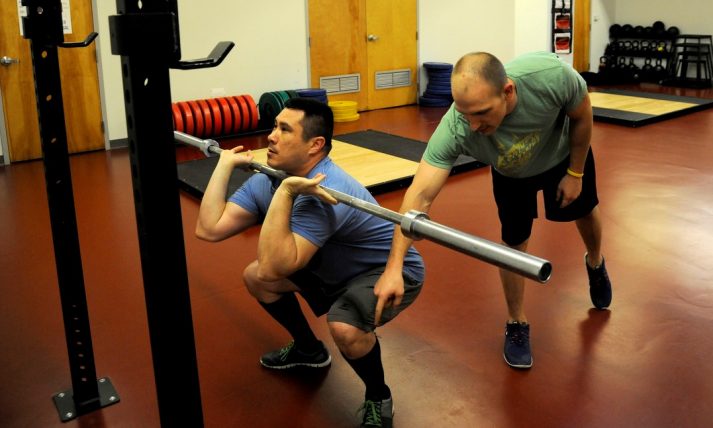
#1) Find your squat rack!
It’ll look something like this, with an unattached barbell:
A. Squat Stand: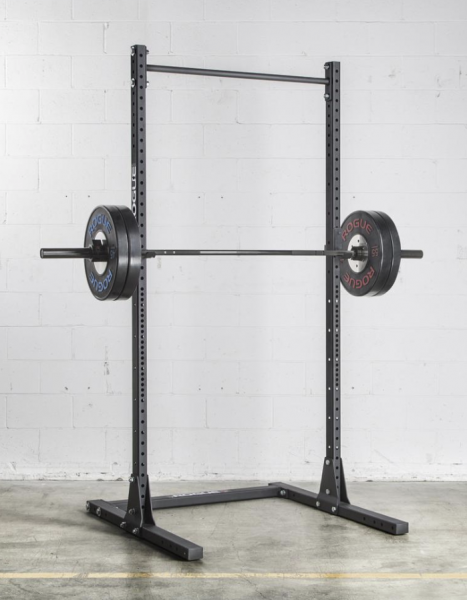
B. Power Cage/Squat Rack
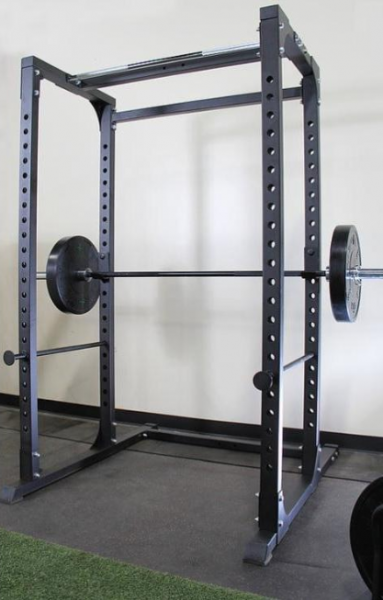
C. Half Rack (Least favorite*):
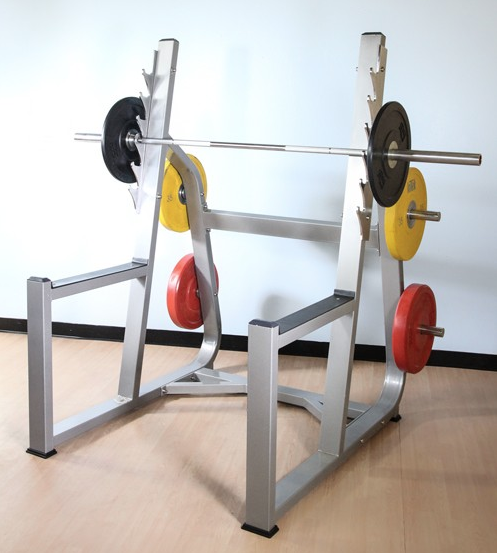
*I don’t like Half-racks without adjustable safety bars – if you want to squat deep the barbell might hit the immovable bars! Not cool.
Aim for the A or B options if you have the choice.
HUGE NOTE: a squat rack is NOT the same thing as a Smith Machine, where the barbell is attached to the machine, and slides up and down two bars:
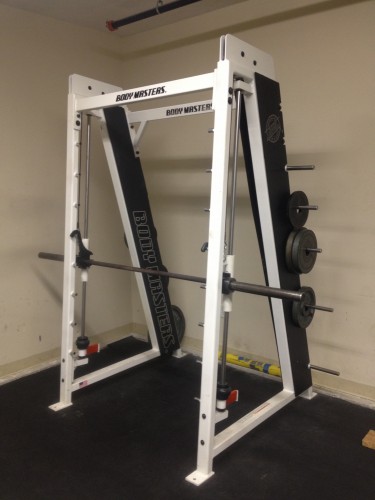
You do NOT want to do front squats in a Smith Machine. Because the bar can’t move horizontally (only vertically), it can put your spine and body in precarious positions and is NOT recommended.
You need a completely unattached barbell in order to do a barbell squat properly and safely.
Friends don’t let friends squat in a Smith Machine.
#2) Next, set the height of the bar to be about the same height as your collarbone.
Not sure how to set the height of the barbell for your front squats? Here’s a video from our Coaching Staff for setting the squat rack, safety bars, and how to properly load weights:
Not sure if you should set the squat rack pins higher or lower? It happens. If your options are either too high or too low, it’s always best to set the pins slightly lower than you need them.
You don’t want to have to get up on your toes to rack/unrack the bar, especially as the weight gets heavier.
Okay, now that we have the bar on the rack and our safety bars in place, we are ready to get started!
How to Do A Proper Front Squat

THE FRONT SQUAT SETUP[2]
1) Step up to the bar, lift your arms, and place the bar on the meaty top/front of your shoulders resting close to your neck (not AGAINST your neck!)
2) Continue lifting your arms and wrap your hands around until you can use your fingers to keep the bar steady!
Depending on your shoulder and write mobility, you might need to adjust your wrist location on the bar.
This is a traditional front squat grip:

See the image below for WIDE grip (if you have mobility issues or longer than average forearms): 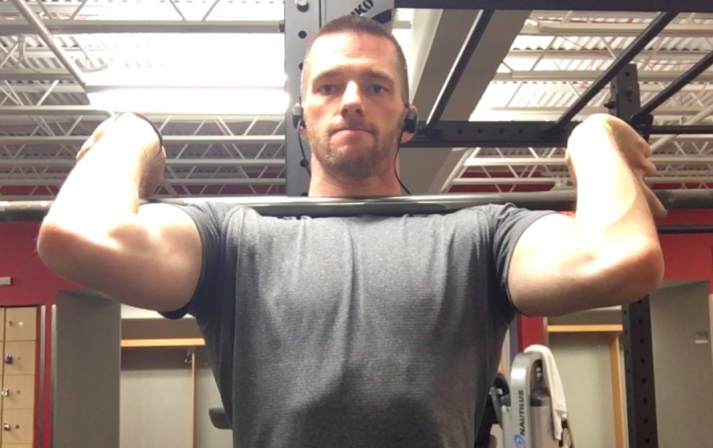
Most people can not front squat with all of your fingers wrapped around the bar, and instead will let the bar roll against their fingertips (a 2-3 finger grip is okay here).
Your fingers are NOT doing any lifting in a front squat: They are merely there to keep the bar on the tops of your shoulders, and to keep the bar from rolling forward if your elbows start to accidentally drop down.
However, if you keep your chest puffed out (like King Kong about to pound his chest), and your elbows UP UP UP, you shouldn’t have any problem here.

If you can’t get your fingers around the bar, there are a few variations you can start training with (specifically, the cross grip squat, which we cover below).
However, we do NOT recommend doing front squats with heavy weight until you can do them with proper form with your grip properly wrapped around the bar and elbows up.
Okay, you’re now ready to do the actual front squat movement.
THE FRONT SQUAT MOVEMENT:
1) Keep your spine tight, your body vertical, chest out and elbows UP UP UP.
2) Lift the bar off the rack, and take one cautious step backward.
3) Your stance should be with your feet hip-width apart, with your toes pointed SLIGHTLY outward (if you have poor hip mobility or very long legs, you might need to squat with a slightly wider stance, that’s okay).
4) Inhale deep into your belly, flex your stomach, and slowly lower your body until your thighs touch the back of your legs. If you don’t squat deep enough, it’s only a partial squat!
5) Staying vertical, keeping your hips underneath the weight, and keeping those elbows UP HIGH, drive down through your feet and lift the weight back to its starting position.
View this post on Instagram
Keeping your elbows as high as possible the entire time is extremely important in the front squat – as soon as you let them drop, the weight will likely pull you forward out of correct positioning, and you will either drop the weight or potentially get injured.
If you can’t do a Front Squat with your arms in the position consider a “cross grip front squat” to START:
Why should you not do front squats with cross grip forever? Because it’s tougher to control the bar at heavier weight without having your hands in a traditional front squat position.
If you’re going to start to lift heavy, you’re gonna need to learn how to fail and bail from a front squat safely.
And it’s very difficult to fail safely while doing a cross grip front squat.
So, sure! Feel free to start with a genie front squat to work on your squat movement, but don’t forget to work on that shoulder and wrist mobility too so you can do front squats properly.
How to Bail Safely on A Front Squat
If you are going to squat, you have to know how to “fail” at squatting safely!
This is where practice can REALLY come in handy. Set the safety pins at the right height, and then practice your bail at a safe weight (or with a PVC pipe) so that the movement becomes second nature if things go poorly!
Make sure you watch the video above to learn how to bail safely with a front squat and back squat.
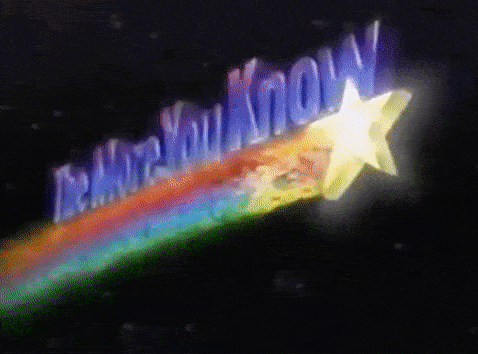
Front Squat: 5 BIGGEST MISTAKES to Avoid
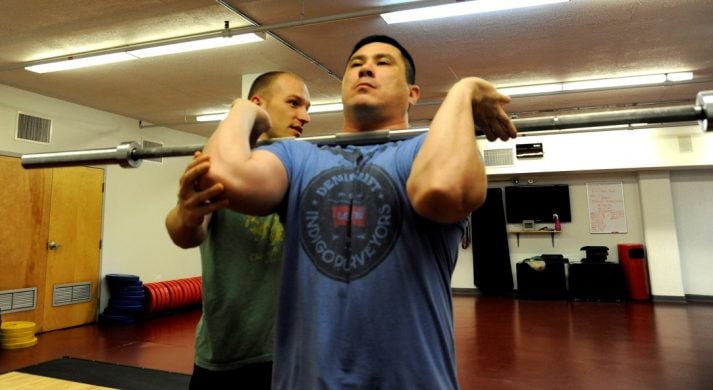
I’ve been front squatting for about a decade, but I’m just one nerd. So I asked the coaches of our Online Coaching Program (with decades of experience between them) what big mistakes they see people make with front squats, both online and in person:
MISTAKE #1) Not staying vertical enough.
If you’ve never done front squats before, it’s a FUNKY maneuver.
You need to keep the weight over the middle of your feet – if you drew a line down from the bar to the floor, it should bisect your feet – which means you need to be significantly more vertical compared to a back squat.
See it in the right image below:

The tendency is to bend forward on a front squat, and this is a recipe for disaster!
SOLUTION: Film a video of yourself doing front squats from the side, and note where the bar is in relation to your feet. Keep your chest puffed out (King Kong!) and elbows up!
MISTAKE #2) Not developing proper shoulder and wrist flexibility.
If we had one more more common problem than the others, it’s that people don’t have the proper shoulder and wrist and arm mobility to be able to grab the bar properly with their fingers.
Although you CAN do a cross-grip front squat, it’s not recommended for heavy weights due to the fact that it’s more difficult to bail from this movement safely.
SOLUTION: Grab the bar wider, or with fewer fingers. Just keep those elbows up!

With each future workout, grab the bar with a slightly closer and closer to your shoulders, or with more fingers.
Develop that mobility!
MISTAKE #3) Not squatting deep enough: ankle and hip mobility.
Most people have poor hip and ankle mobility – it’s from spending all day sitting in desk chairs or cars. This is the most common fault I see in gyms around the world: people doing a barbell squat and only dropping down a few inches and thinking it’s a full squat.
We call this a “power curtsy:”

If you don’t squat deep enough – until the tops of your thighs are parallel or lower, then you’re only doing half a repetition and cheating yourself!
See the difference in depth between a half-rep and a VERY deep front squat below.
You can go deep enough until the tops of your thighs are below parallel, and if you have the mobility and depth, until your hamstrings hit your calves:

SOLUTION: Take a slightly wider stance, and turn your feet out slightly more. This will help you squat deeper to start.
You can also do some ankle mobility drills to improve your ankle flexion!
Lastly, spend more time sitting in a squat!
I try to do up to 30 minutes per day sitting in the bottom of a squat (while watching TV, or while reading a book):

MISTAKE #4) Not learning to bail properly.
If you’re gonna get strong, you’re going to want to lift heavier and heavier things. Sometimes when you lift heavy things, you’re going to fail on that lift.

It’s part of lifting, so you might as well learn to bail correctly NOW! There’s nothing more scary than realizing you’re not gonna hit a lift and being trapped under a bar with no way of getting away from the weight safely!
Practice how to fail and bail so that you can have more confidence to try and succeed.
MISTAKE #5) Pressing the weight against your throat.
When you do a front squat, you have the bar resting across the tops of your shoulders, held in place by your fingers with your elbows up.
However, the bar is also resting precariously close to your throat and your windpipe!
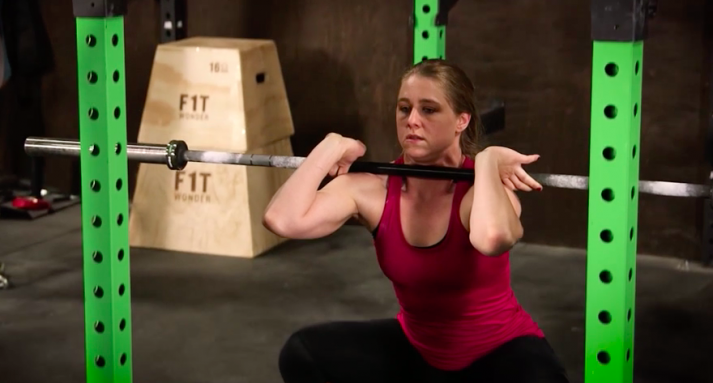
If you happen to get your elbows TOO high, or if you use your fingers to press the bar against your throat too much, you are in danger of restricting your air passage.
Serious injury can occur if you manage to black out in a front squat due to the bar resting against your throat.
If you happen to notice ANYTHING unusual with your vision, breathing, or awareness during a front squat lower the weights onto the safety bars or re-rack the weight and drop to one knee IMMEDIATELY.
Get low to the ground in case you get light headed!
Front Squat: How do I put Front Squats in My Workout (Next Steps)
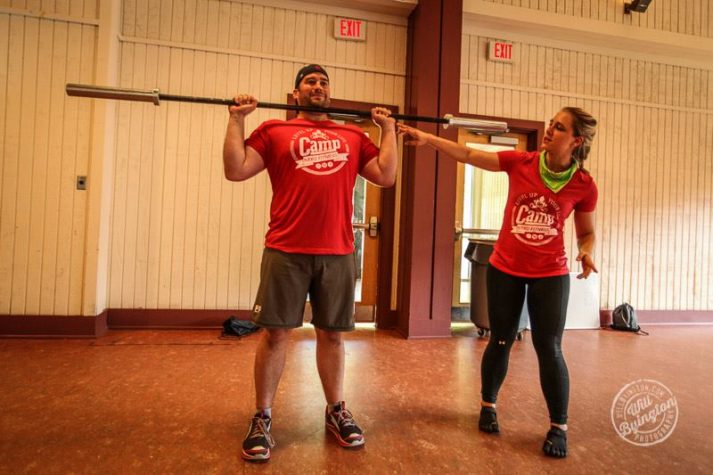
Front squats are an AMAZING exercise, and you should now have everything you need to be able to confidently do front squats with correct form and proper technique.
I’m sure you have a few more questions:
#1) “How do I fit front squats into my workout? Where do they go?”
If you are building your own workout, feel free to alternate each squat workout with either a back squat or a front squat.
I train 4 days per week, and do higher rep back squats on Wednesdays, and then heavier, low rep front squats on Saturdays.

Depending on your situation, you might decide to ONLY do front squats moving forward, or ONLY back squats.
Check with your coach or your personal trainer or whoever is building your program, or experiment yourself!
#2) “How much weight should I lift when doing front squats?”
As we cover in our “how much weight should I lift?” guide, always start with just the bar during your warm-up sets.
And then slowwwwly, over many weeks, can you start to ramp up the weight.
Your goal should be to confidently build strength each week while also improving your form each and every time too.
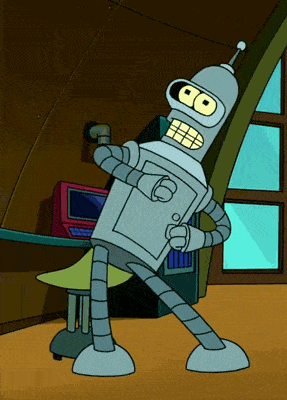
#3) “Can you build a workout for me that has front squats, Steve?”
We do have a pretty killer 6-Level Gym Workout Program that you can do front squats in.
If you’re looking for a custom-tailored workout program or a supportive community to hang out with and cheer you on, I got a few options for ya:
1) Not sure if you squatted deep enough or if your form sucks? Not sure HOW to train in a gym quite yet? You’re not alone. This is what we do for a living!
If you want an expert to check your front squat form, we have a 1-on-1 Online Coaching Program.
Our coaching app lets you record and send a video of your movement directly to your coach, who will provide specific feedback and build a custom program just for you.
2) Good at following instructions and want a blueprint to follow? Check out our self-paced online course, the Nerd Fitness Academy.
The Academy has 20+ workouts for both bodyweight or weight training, a benchmark test to determine your starting workout, HD demonstrations of every movement, boss battles, meal plans, a questing system, and supportive community.
3) Join our free community, the NF Rebellion! You can download our free Strength 101 Guide, which you can get when you sign up in the box below:
- Everything you need to know about getting strong.
- Workout routines for bodyweight AND weight training.
- How to find the right gym and train properly in one.
So I have just a few questions for you:
- What do you like better, front squats or back squats?
- What sort of challenges do you have on front squats?
- Any other questions? How else can I help?
If you have more questions about how to fit front squats into your workout, please leave them in the comments below.
Big or small, what questions do you have on the Front Squat?
-Steve
PS: Here are our other free articles in the Strength 101 Series:
- Strength Training: How to Get Strong
- Beginner Strength Training Routines
- 6 Beginner Gym Workouts to Follow
- How much weight should I be lifting?
- How to do Inverted Bodyweight Rows
- How to Squat Properly
- How to do the Overhead Press
- How to Get Your First Pull-up
###
PHOTO SOURCES:[3]

